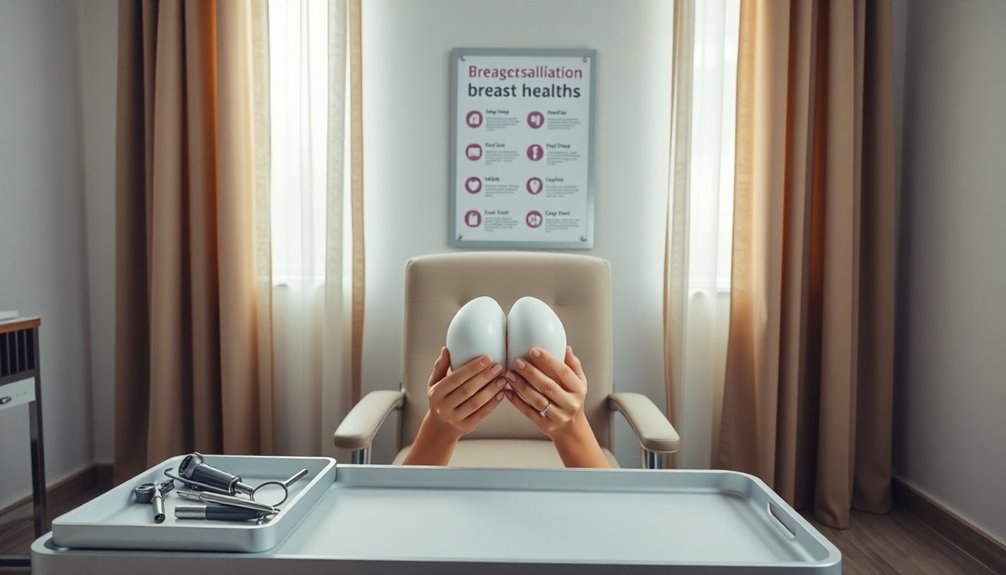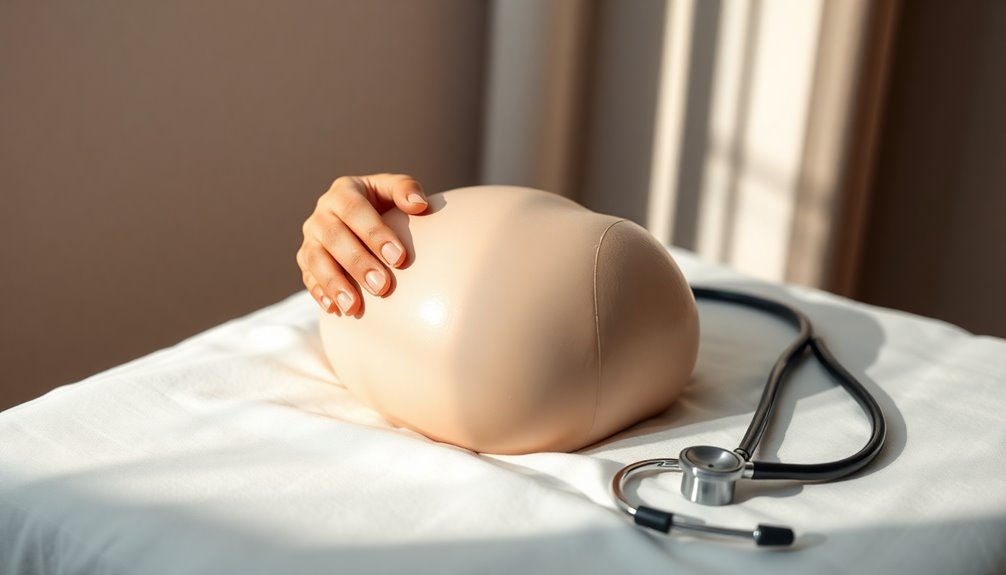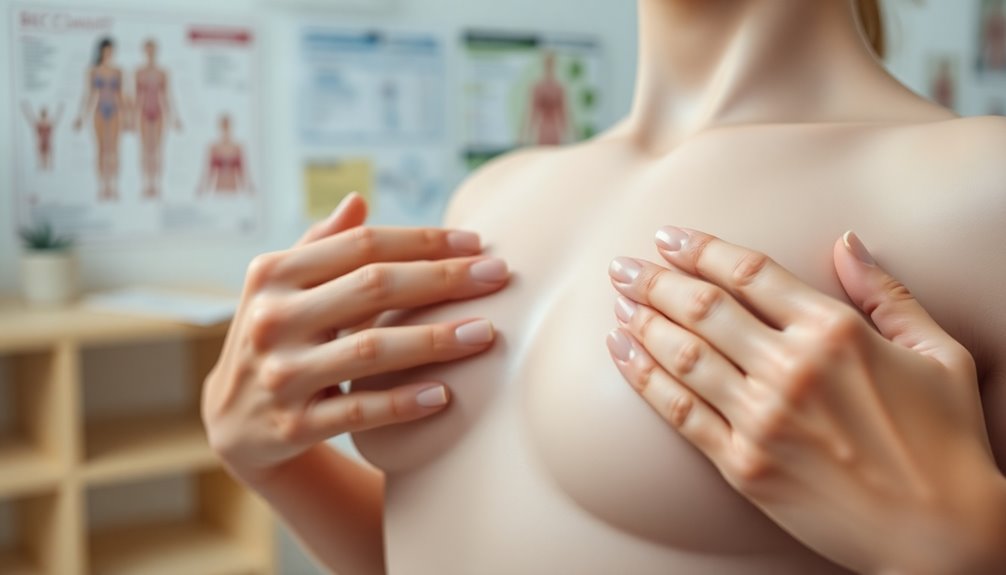Breast self-exams are crucial in spotting potential issues, with almost 40% of breast cancer cases detected by women noticing changes themselves. By performing regular monthly checks, you can become familiar with what's normal for you and spot any unusual changes. It's imperative to know when to perform these exams, the techniques to use, and what symptoms to look for. Stay informed about the importance of self-exams and how they work alongside professional screenings to protect your health.
Key Takeaways
- Breast self-exams empower individuals to recognize changes in breast tissue, crucial for early detection of potential issues.
- Regular self-exams can lead to earlier diagnosis, significantly improving treatment outcomes and reducing the need for aggressive therapies.
- Performing self-exams monthly helps familiarize with normal breast structure, making it easier to spot unusual changes over time.
- Many breast cancer cases are detected by women noticing lumps during self-exams, highlighting their importance in proactive health management.
- Community resources and educational initiatives enhance awareness and provide support for effective breast health practices among individuals.
What Is A Breast Self-Exam?

A breast self-exam is an essential tool for monitoring your breast health. It combines physical and visual inspections to help you identify any changes in your breasts, such as lumps or skin abnormalities.
By performing regular breast self-exams, you empower yourself to become familiar with your normal breast appearance and feel, which aids in early detection of potential issues, including breast cancer.
It's recommended to conduct these exams monthly—ideally a few days after your menstrual period ends or on a consistent day if you're postmenopausal.
Make sure to check your breasts in different positions: standing, lying down, and in front of a mirror.
If you notice any changes, like new lumps or alterations in nipple appearance, report them to your healthcare provider.
The Importance of Regular Self-Exams

Regular self-exams are essential for spotting changes early, which can lead to better treatment outcomes.
By making it a monthly routine, you empower yourself to understand your body and recognize any unusual signs.
Staying aware of your breast health is an important step in taking charge of your well-being.
Early Detection Benefits
While many women might overlook the importance of self-exams, they play a crucial role in early breast cancer detection.
Regular breast self-exams help you become familiar with your breast tissue, making it easier to spot any unusual changes or lumps. In fact, about 40% of diagnosed breast cancers are found by women who notice these changes themselves.
Early detection through self-exams can lead to less aggressive treatment options, reducing the need for extensive surgeries or chemotherapy. This proactive approach greatly improves treatment outcomes and survival rates.
Given that breast cancer is one of the most common cancers among women, incorporating self-exams into your routine is essential for maintaining your breast health and empowering yourself in the fight against this disease.
Monthly Routine Importance
Incorporating monthly self-exams into your routine greatly enhances your ability to detect any changes in your breast tissue. By performing a breast exam regularly, you become familiar with your unique breast structure, making it easier to spot any unusual size, shape, or texture changes.
It's best to schedule your self-exams a few days after your menstrual period ends or pick a consistent date each month if you're postmenopausal. This consistency boosts your breast awareness and empowers you in managing your health. Additionally, being aware of common symptoms can lead to timely diagnosis and better outcomes.
Empowering Health Awareness
How can you take charge of your breast health? By committing to regular self-exams, you empower yourself to know your breasts better.
Aim to perform these exams once a month, ideally a few days after your period, when hormonal changes are minimal. This proactive approach helps you identify any changes, such as lumps or alterations in skin texture, which are vital signs and symptoms of potential breast cancer.
Remember, about 40% of diagnosed cases are first noticed by individuals through self-exams. By staying attuned to your body, you can greatly reduce your breast cancer risk and guarantee early detection.
Don't hesitate to consult a healthcare provider if you notice anything unusual. Your health is in your hands!
When to Perform Breast Self-Exams

You should perform breast self-exams monthly to stay in tune with your body.
For menstruating women, the best time is a few days after your period ends, while postmenopausal individuals should pick a consistent date each month.
This routine helps you notice any changes and enhances your breast health management.
Best Timing for Exams
Timing plays an essential role in performing breast self-exams effectively. For menstruating individuals, the best timing for exams is just a few days after your period ends. This is because hormonal fluctuations can affect breast tissue, making it easier to detect changes.
If you're postmenopausal, choose a specific date each month for your breast self-exams. Consistency is important, as performing self-exams at the same time monthly helps you recognize any new or unusual changes in your breast tissue.
Monthly Routine Importance
Establishing a monthly routine for breast self-exams is vital for maintaining awareness of your breast health.
For menstruating women, the best time to conduct these self-exams is a few days after your period ends when hormonal fluctuations are at their lowest. If you're postmenopausal, choose a consistent date each month to help you remember.
Regular monthly checks allow you to recognize unusual changes over time, making it easier to spot new lumps or alterations in breast tissue. This awareness greatly aids in early detection of breast cancer, which is essential for effective treatment.
Post-Menopausal Consistency
While hormonal changes no longer dictate the timing of breast self-exams for post-menopausal individuals, maintaining a consistent schedule is essential. Choose a specific day each month to check for changes in your breast health, like the first of the month. This routine empowers you to notice any abnormalities early, which is vital as your breast cancer risk increases with age.
| Day of the Month | Action | Importance |
|---|---|---|
| 1 | Perform Self-Exam | Early Detection |
| 15 | Record Changes | Monitor Health |
| 30 | Review Findings | Stay Informed |
| Anytime | Consult a Doctor | Seek Professional Help |
Establishing this habit enhances your awareness and promotes ongoing health vigilance.
Techniques for Effective Self-Exams

A regular self-exam is an essential step in monitoring your breast health. Aim to perform self-exams monthly—ideally a few days after your menstrual period ends, or on a consistent date if you're postmenopausal.
Use the pads of your fingers to feel for lumps, thickening, or changes in texture, applying varying pressure as you examine. Check your breasts in three positions: in the shower, in front of a mirror for visual inspection, and lying down to evenly spread the breast tissue.
Cover the entire area, including underarms and collarbone, using a systematic pattern like the "clock" method. Document any changes and consult a healthcare professional promptly if you notice anything unusual.
What Changes to Look For

When it comes to breast health, being vigilant about changes is essential. Start by checking for noticeable lumps or masses; about 40% of diagnosed breast cancers are found when women feel a lump during self-exams.
Pay attention to any change in your breast, like alterations in skin texture, such as dimpling or puckering, which can indicate underlying issues. Monitor your nipples for any discharge or inversion, as these can be potential red flags.
Additionally, observe for swelling or significant changes in breast size or shape. Finally, don't ignore any unexplained pain or tenderness in the breast area.
Next Steps After Finding Changes

What should you do if you notice changes during your breast self-exam?
First, document your findings, noting the size, shape, and any unusual texture or tenderness.
Then, schedule an appointment with a health professional as soon as possible.
Be ready to discuss your observations in detail, as this information is essential for determining necessary diagnostic procedures.
Here's a quick checklist of steps to follow:
- Document your findings thoroughly.
- Schedule an appointment with your healthcare provider.
- Be prepared to discuss your observations.
- Follow through with recommended diagnostic procedures (mammograms, ultrasounds).
- Stay informed about breast health resources.
Taking these steps can help guarantee your health remains a priority and any changes are addressed promptly.
Can Self-Exams Replace Professional Screenings?

Can self-exams truly take the place of professional screenings? While self-exams are an excellent way to familiarize yourself with your breasts, they can't replace professional screenings like mammograms. Mammograms can detect tumors before they're even palpable, making them essential for early breast cancer detection. Research shows 40% of diagnosed cases are found by women noticing lumps, highlighting the importance of combining self-exams with regular medical check-ups.
| Aspect | Self-Exams | Professional Screenings |
|---|---|---|
| Main Purpose | Familiarization | Early Detection |
| Detection Capability | Lumps | Tumors not yet palpable |
| Recommended Frequency | Monthly | Every 1-2 years (ages 50-74) |
Regular professional screenings are crucial for ensuring your health.
Understanding Breast Changes Over Time

As you journey through life, your breasts will naturally undergo various changes due to hormonal shifts, pregnancy, and menopause.
It's crucial to know how your breasts normally look and feel, so you can spot new or unusual changes.
Consider these common changes:
- Hormonal fluctuations during your menstrual cycle can cause tenderness.
- Pregnancy and breastfeeding may alter breast texture and size.
- Post-menopausal changes often lead to decreased tissue density.
- Aging shifts breast composition from glandular to fatty tissue.
- Awareness of lumps or asymmetries can highlight symptoms of breast cancer.
Regular self-examinations empower you to recognize these changes, ensuring timely medical evaluation if needed.
Always stay informed about your body to promote lifelong breast health.
Community Awareness and Support Initiatives

While many people mightn't realize it, community awareness and support initiatives play an important role in promoting breast health.
These initiatives, like public health talks, greatly enhance understanding of breast cancer and the importance of self-examinations. By participating in educational events, you can share knowledge and encourage others to engage in regular breast health checks.
Resources such as the TLC (Touch, Look, Check) infographic help spread crucial information about recognizing breast changes.
Social media also serves as a powerful tool for raising awareness, sparking discussions about breast health and self-examination practices.
Getting involved in community organizations focused on breast cancer not only provides support but also offers opportunities to contribute to important research and awareness campaigns.
Resources for Breast Health Education

When it comes to breast health education, you've got plenty of resources at your fingertips.
Educational workshops in your community can teach you essential self-exam techniques, while online resource centers offer valuable information you can access anytime.
Don't forget to check out local health initiatives that promote awareness and support in your area.
Educational Workshops Available
Educational workshops on breast health are essential resources that empower you to take charge of your well-being.
These interactive sessions provide crucial knowledge about self-examinations, enabling you to recognize signs of breast changes effectively.
Many community organizations offer free workshops that focus on:
- Techniques for performing self-exams
- Understanding signs and symptoms of breast cancer
- Importance of regular checks for early detection
- Resources for mammography and clinical breast exams
- A supportive community atmosphere for sharing experiences
Online Resource Centers
How can you stay informed about breast health and the importance of early detection? Online resource centers are a fantastic way to access valuable information. Organizations like the American Cancer Society and Breastcancer.org offer free educational materials, webinars, and support groups that enhance your understanding of breast self-exams and their role in early detection.
Here's a quick look at what you can find:
| Resource Type | Examples |
|---|---|
| Educational Materials | Guidelines for breast self-exams |
| Interactive Tools | Videos and infographics on breast health |
| Community Support | Online support groups and events |
These resources empower you to take charge of your breast health and encourage timely medical consultations when you notice changes. Stay informed, stay proactive!
Community Health Initiatives
Many people may not realize the valuable resources available through community health initiatives focused on breast health education.
These initiatives play a vital role in raising awareness about the importance of regular screenings and self-exams.
Here's what you can find:
- Free educational workshops on breast health
- Awareness events during Breast Cancer Awareness Month
- Downloadable guides like the TLC (Touch, Look, Check) method
- Free or low-cost screening mammograms for at-risk individuals
- Social media campaigns sharing personal stories
Frequently Asked Questions
What Causes Electric Shock Feeling in Breast?
Electric shock feelings in your breast can stem from nerve irritation or compression, often linked to conditions like fibrocystic changes or costochondritis.
Hormonal fluctuations during your menstrual cycle can heighten sensitivity, causing unusual sensations.
If you've had breast surgery or trauma, nerve damage might be the culprit.
In some cases, conditions like multiple sclerosis or neuropathy can also create these sensations.
If it persists, consult a healthcare provider for guidance and treatment options.
What Is an Abnormal Finding of the Breast Self Exam?
During a breast self-exam, you should look for abnormal findings like noticeable lumps or masses that feel different from the surrounding tissue.
Pay attention to any changes in skin texture, like dimpling or swelling. If you notice alterations in the nipple, such as discharge or inversion, those are significant.
Sudden changes in size or shape, especially in one breast, along with unexplained pain, should prompt you to consult a healthcare professional.
Why Are Breast Exams No Longer Recommended?
Breast exams aren't recommended anymore because research shows they don't markedly reduce breast cancer mortality rates.
You might find that self-exams can cause unnecessary anxiety and lead to misinterpretations of benign lumps as concerning. Organizations like the U.S. Preventive Services Task Force suggest focusing on regular clinical exams and mammograms instead, which are more effective.
However, staying aware of your breast health and recognizing changes still matters for timely medical consultation.
What Are the Red Flags for Breast Exams?
When you think of health, consider both the obvious and the subtle signs.
During breast self-exams, watch for red flags like new lumps or hard masses that need immediate attention.
Don't ignore changes in skin texture, nipple appearance, or any swelling.
If one breast looks different from the other, or if you experience unexplained pain, it's essential to consult a healthcare professional.
Your awareness could make a significant difference in your health journey.
Conclusion
In a world where "an ounce of prevention is worth a pound of cure," taking charge of your breast health through regular self-exams is essential. By knowing your body and performing these exams consistently, you empower yourself to spot changes early. Remember, self-exams don't replace professional screenings but are an important part of your overall health routine. Stay informed, stay proactive, and don't hesitate to reach out for support when needed. Your health is in your hands!









